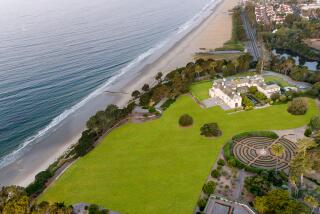‘The Worth . . . of an Architect’
The week hadn’t been going well at all for the La Canada Flintridge Historical Society when it got together Tuesday for an evening of friendship and learning.
Some of their leaders had just been to Monday’s City Council meeting and found themselves bruised by the closest thing this wealthy and usually reserved city has seen to an angry mob.
The hostility wasn’t intended for them. About 200 residents were there to vent their disapproval of the shopping center proposed by the Sport Chalet. The Historical Society merely had the bad luck of showing up on the same night supporting a plan to make a museum of the 1915 home of the city’s pioneering Lanterman clan.
They won a 3-2 vote to proceed with hearings on the plan. But they may have lost the goal, as the crowd broke into a chant, “3-2! 3-2! 3-2!” mocking the council’s old-guard majority.
Two of those three votes will leave the council when their terms expire next month, almost guaranteeing that the 3-2 split will be rearranged in favor of the crowd.
The chants were still battering June Dougherty’s sensibilities Tuesday when the volunteer historian of the Lanterman family gave her report to about 40 members gathered in the expansive living room of a Tudor mansion on Inverness Street, far from the noise of the crowd.
Like many of them, Dougherty is simple and self-effacing, given to books and ideas over fashion and power. She’s of library, not political, stock.
“It was a horrifying thing,” she said over and over.
But those of positive mind create their own good fortune. Dougherty’s report was passed over expeditiously, with the shaking of many heads, to get on to a happier theme.
Their speaker, Karen Hudson, provided it. She is the granddaughter of Paul Williams, a black architect who for 60 years spread grace and comfort to every corner of Los Angeles. Williams is not usually listed with the Wrights and Neutras. He was more like the popular songwriter whose melodies are better remembered than his name.
Among his works are the prominent Tudor castle on San Rafael in Pasadena, the Second Baptist Church in South-Central Los Angeles and Saks Fifth Avenue in Beverly Hills.
Williams also had a special connection to La Canada Flintridge. He designed at least 60 of the Tudor and Country English mansions that distinguish the Flintridge section.
An orphan at 4, he sold newspapers from a stand at First and Spring streets in Los Angeles. There he came to the attention of U.S. Sen. Frank P. Flint, who later developed Flintridge and cultivated Williams’ work.
Hudson is researching a book on her grandfather. She came seeking information as well as giving it. She handed out a list of her grandfather’s Flintridge homes. Almost half showed year and original owner, but no address.
“I actually have the plans,” she said. “But apparently there was nothing out here. If it was the Hall House, they knew where it was. They didn’t have to put the address on the plans.
“If any of you happen to know anyone whose original owner was one of these names, we’d be thrilled to find out.”
Hudson hoped to show that her grandfather was more than a designer of mansions for the rich. She showed photos of his unusual works, such as the Al Jolson Shrine in Culver City and the radial-shaped St. Jude Hospital in Memphis, Tenn., which came to him in a dream.
She also played down the legend that Sen. Flint helped the young Williams through USC.
“I did not know who Sen. Flint was, but I knew the name Flintridge,” she said. “It was not until he was actually practicing architecture that they reacquainted themselves and Sen. Flint was instrumental . . . in influencing him to go out on his own and gave him jobs out here.”
Hudson interspersed family snapshots and interesting architectural tidbits.
“Homes that were built in Prohibition invariably have a secret room somewhere,” she said. “In fact, one home on Berkshire, the contractor was in there and said, ‘Let me show you this,’ and the owner said, ‘I never saw that before.’ It was a wall behind a wall. It actually went down to a full cellar.”
She said she has learned never to judge from the outside that a house is not her grandfather’s work. It was the richness of the interior detail that held his signature, she said.
On that count, there was no doubt who had created the generously detailed Tudor home on Inverness. After Hudson’s talk, its owner since 1959, Fred Ostendorf, described some of its signature touches including a separate room in the foyer for the phone and another in the basement for the incinerator ashes.
“All the little amenities that make for happy living, and easy living and thoughtful living are here,” he said.
Hudson thanked him on behalf of her grandfather.
“He thought that the worth of himself as an architect was that he could please his client,” she concluded.
At least until election day, the La Canada Flintridge Historical Society is restored in spirit.
More to Read
The biggest entertainment stories
Get our big stories about Hollywood, film, television, music, arts, culture and more right in your inbox as soon as they publish.
You may occasionally receive promotional content from the Los Angeles Times.











